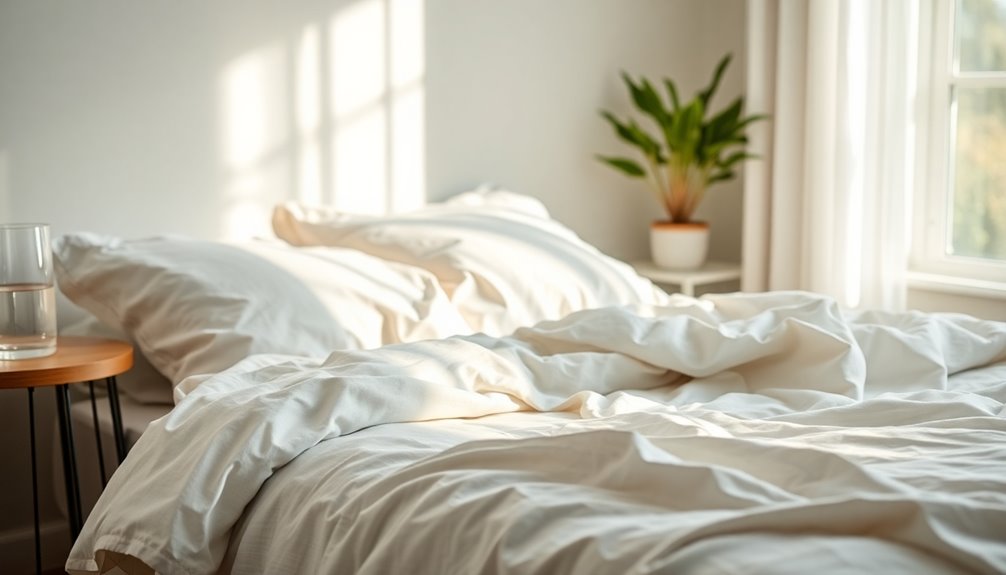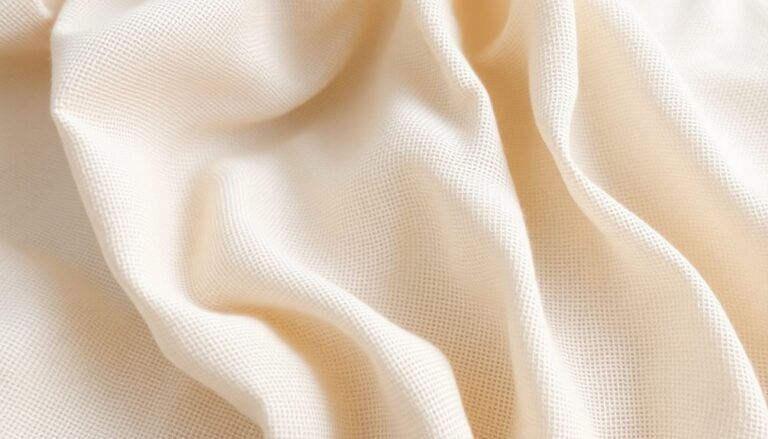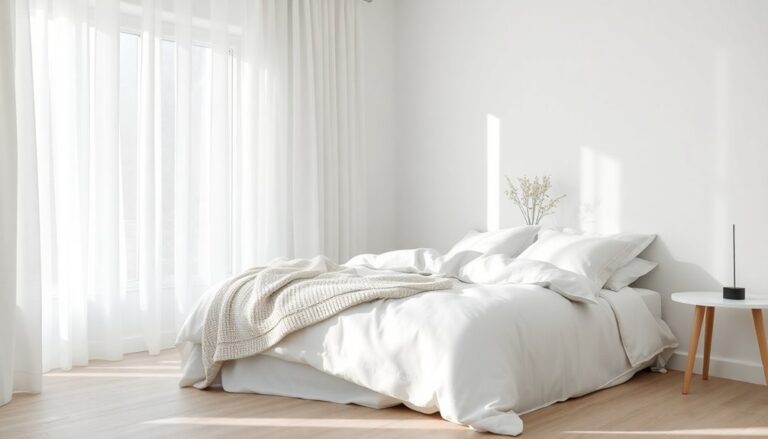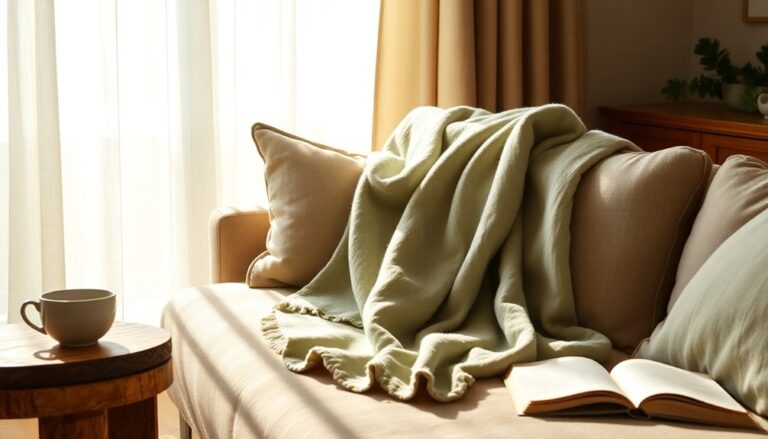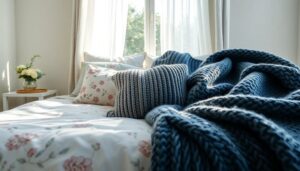Linen bedding offers significant benefits for people dealing with night sweats. Its natural breathability keeps air circulating, preventing heat buildup. The moisture-wicking properties draw sweat away from the skin, promoting quick evaporation and a cooling effect. Linen is furthermore hypoallergenic, reducing the risk of skin irritations during being easy to maintain. With various stylish options, it combines comfort and practicality. Exploring further can reveal even more reasons why linen is ideal for a restful night's sleep.
Article Highlights
- Linen's natural breathability allows for airflow, helping to dissipate heat and keep you cooler during the night.
- Its moisture-wicking properties draw sweat away from the skin, promoting quick evaporation and reducing discomfort from night sweats.
- Linen's hypoallergenic nature prevents the trapping of allergens, creating a healthier sleep environment for those sensitive to irritants.
- The fabric's durable and long-lasting quality ensures it maintains its breathable properties, providing consistent comfort over time.
- Linen dries quickly and is easy to maintain, allowing for fresh and clean bedding that supports restful sleep.
What Causes Night Sweats?
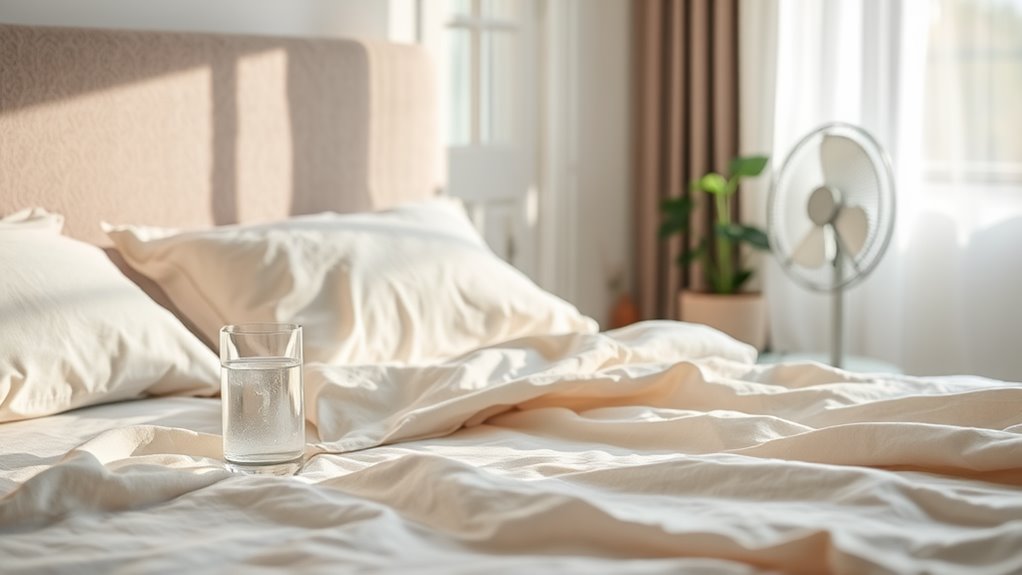
Night sweats can be uncomfortable and disruptive, often leaving individuals searching for answers. One common cause of night sweats is hormonal changes, particularly during menopause or menstruation. Women may experience fluctuations in estrogen levels, leading to sudden heat sensations that disrupt sleep. Furthermore, certain medication side effects can contribute to night sweats. Antidepressants, steroids, and some diabetes medications have been known to trigger excessive sweating during the night. These physiological changes can create an uncomfortable sleep environment, prompting those affected to seek solutions. Comprehending these underlying causes can help individuals address their symptoms more effectively, allowing for improved sleep quality and overall well-being.
The Breathability of Linen
With regard to choosing fabrics for sleep, the breathability of linen stands out as a key factor, especially for those experiencing night sweats. Linen fabric is crafted from flax fibers, which are naturally breathable. This means air circulates easily, allowing heat to escape and preventing the buildup of moisture. Unlike synthetic materials that can trap heat, linen's breathable fibers promote a cooler sleep environment. Furthermore, linen's loose weave improves its ability to allow air to flow freely, making it an ideal choice for restless sleepers. Those who suffer from night sweats often find that bedding made from linen fabric helps regulate their body temperature, contributing to a more comfortable night's sleep. Embracing linen can truly make a difference.
Moisture-Wicking Properties of Linen
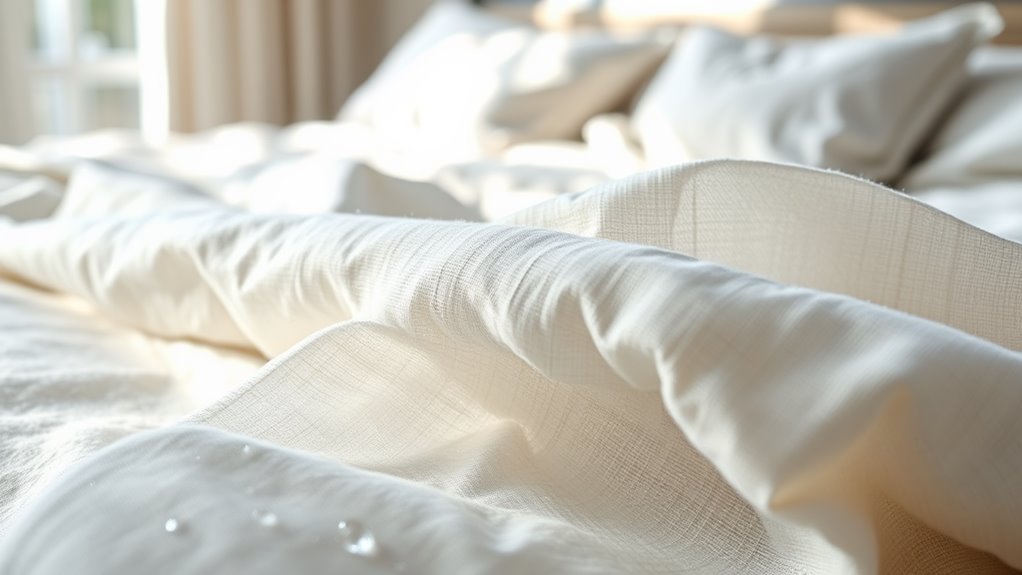
Linen's moisture-wicking properties make it an excellent choice for those dealing with night sweats. This natural fabric performs exceptionally in moisture absorption, drawing sweat away from the skin and allowing it to evaporate quickly. As a result, users often experience a revitalizing cooling effect, which helps maintain comfort throughout the night. Unlike synthetic materials that can trap heat and moisture, linen promotes a dry sleeping environment, reducing the discomfort associated with excessive sweating. Its unique structure allows for airflow, further enhancing its ability to keep the body cool. For individuals struggling with night sweats, incorporating linen into their bedding or sleepwear can lead to a more restful and enjoyable night's sleep, free from the irritation of damp fabrics.
Temperature Regulation With Linen
For those experiencing night sweats, temperature regulation becomes a key concern. Linen is naturally breathable, allowing air to circulate freely, which helps manage temperature fluctuations throughout the night. Unlike synthetic fabrics that trap heat, linen's lightweight nature enables it to wick away moisture, making it an ideal choice for those prone to overheating. This effective moisture management can considerably improve sleep quality by reducing nighttime disturbances caused by discomfort. As the body cools, linen works to maintain a superior sleeping environment, ensuring that individuals can enjoy restorative rest without the interruptions of excessive heat or humidity. Choosing linen bedding can provide a soothing solution for those seeking better temperature control during restless nights.
Softness and Comfort of Linen
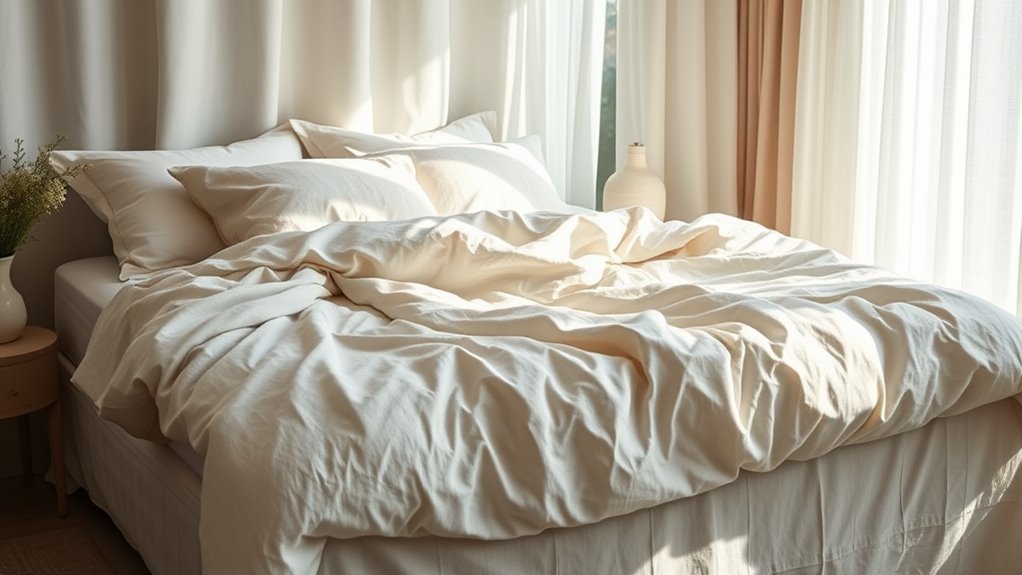
Linen's natural breathability makes it a top choice for those experiencing night sweats, offering a soft touch that improves comfort. Its moisture-wicking properties help keep the skin dry, ensuring a restful night's sleep. Together, these features create an inviting environment for anyone struggling with nighttime discomfort.
Natural Breathability Benefits
Though many fabrics can trap heat and moisture, linen stands out due to its remarkable natural breathability. This quality allows air to circulate, helping regulate body temperature, which is essential for those experiencing night sweats. The unique linen texture not only feels soft against the skin but also contributes to a comfortable sleep environment. Additionally, linen colors come in various shades, adding an aesthetic appeal while maintaining functionality.
| Benefits | Description |
|---|---|
| Breathability | Promotes airflow for temperature control |
| Softness | Gentle feel against the skin |
| Versatility | Available in different colors |
| Durability | Long-lasting and resilient fabric |
These features make linen a top choice for comfort and relief during sleepless nights.
Moisture-Wicking Properties
Building on its breathability, linen furthermore boasts impressive moisture-wicking properties that improve its softness and comfort. This natural fabric thrives in moisture absorption, quickly drawing sweat away from the skin. As a result, it promotes sweat evaporation, keeping the sleeper feeling fresh and dry throughout the night. Unlike synthetic materials that can trap moisture, linen allows for a more comfortable sleeping experience by regulating temperature and preventing clamminess. Its unique texture contributes to a gentle touch against the skin, ensuring that those experiencing night sweats can enjoy restful sleep without discomfort. Overall, the moisture-wicking properties of linen make it an ideal choice for individuals seeking relief from night sweats during the pursuit of comfort and softness.
Durability and Longevity of Linen
When considering fabrics for night sweats, one can't overlook the remarkable durability and longevity of linen. This eco-friendly fabric, often derived from sustainable sourcing practices, not only withstands the wear and tear of daily use but likewise maintains its aesthetic appeal over time. Linen's resilience means it can endure countless washes without losing its shape or texture, making it a wise investment for those seeking comfort and practicality.
- It softens with each wash, becoming more inviting.
- Its natural fibers resist fraying and fading, ensuring long-lasting beauty.
- Linen's breathability remains intact, providing comfort through years of use.
Choosing linen isn't just about immediate relief from night sweats; it's about embracing a fabric that stands the test of time.
Hypoallergenic Benefits of Linen
Linen's impressive durability and longevity extend beyond its physical attributes; it also offers significant hypoallergenic benefits. With its natural fibers, linen exhibits hypoallergenic properties that make it an excellent choice for those with skin sensitivity. Unlike synthetic materials, linen doesn't trap allergens like dust mites or mold, promoting a healthier sleep environment. This is particularly beneficial for individuals prone to allergies or skin irritations, as linen helps reduce the risk of flare-ups. Moreover, its breathable nature allows for better air circulation, further minimizing moisture buildup that can exacerbate skin issues. For anyone struggling with night sweats or sensitivities, linen provides a soothing, hypoallergenic alternative that promotes restful sleep without triggering discomfort.
Easy Care and Maintenance of Linen
In terms of care and maintenance, linen stands out for its ease of use. It has a quick washing process that saves time, whereas its durable fabric guarantees longevity, making it a smart investment. Plus, linen's natural stain resistance means less hassle in keeping it looking fresh.
Quick Washing Process
Although many fabrics require special care, linen stands out for its straightforward washing process, making it an ideal choice for those dealing with night sweats. With its quick drying capabilities, linen can be washed and ready to use in no time. This easy laundering method alleviates the stress of maintaining cleanliness during hot nights, ensuring comfort and freshness.
- No complicated washing instructions to follow
- Enjoy the relief of quickly dried bedding
- Feel confident in your choice of fabric
For people facing night sweats, the simplicity of linen's care routine allows them to focus on restful sleep instead of laundry worries. Its easy maintenance contributes to a more peaceful and stress-free sleeping environment.
Durable Fabric Longevity
Durability is a key advantage of linen, especially for those dealing with night sweats. Its strong fibers withstand repeated washings and regular wear, making it a long-lasting choice for bedding. Durability factors like the natural resilience of linen mean it can handle the moisture that often accompanies night sweats without losing its shape or comfort.
Furthermore, fabric care is simple and straightforward. Linen can be machine washed and dried, which is ideal for busy individuals. With proper care, such as avoiding excessive heat during drying, linen maintains its quality over time. This easy maintenance not only improves its longevity but likewise allows users to enjoy a comfortable sleep environment without the hassle of complicated washing routines.
Natural Stain Resistance
One of the standout features of linen is its natural stain resistance, making it an excellent choice for those prone to night sweats. This inherent quality means that linen can handle unexpected spills and stains better than many other fabrics, providing peace of mind for restless sleepers.
- Enjoy restful nights without the worry of stains.
- Experience the fabric benefits of easy cleaning.
- Feel confident in your bedding choices.
With its natural resistance to staining, linen not only simplifies care and maintenance but also improves comfort. Those dealing with night sweats can appreciate how this durable fabric remains fresh and inviting, allowing for a more tranquil sleep experience. It's a perfect blend of practicality and luxury for anyone seeking relief.
Stylish Options for Linen Bedding
Although many people seek comfort in their bedding choices, linen offers a stylish and sophisticated option that improves any bedroom decor. With its natural texture and breathable qualities, linen raises the aesthetic of sleeping spaces. Consumers can find linen bedding in a variety of trendy colors, ranging from muted earth tones to lively hues, allowing for personalization that suits individual tastes. Furthermore, decorative patterns, such as stripes, florals, or geometric designs, add a touch of flair as they maintain elegance. This versatility means that linen bedding can easily complement any interior style, whether it's modern, rustic, or bohemian. In the end, linen combines both fashion and function, making it an excellent choice for those looking to improve their bedroom's visual appeal without sacrificing comfort.
How to Choose the Right Linen for Night Sweats
When selecting linen for night sweats, it's important to focus on specific qualities that improve comfort and regulate temperature. Different linen types, such as pure linen or linen blends, can notably impact breathability. Furthermore, considering fabric weights is essential; lighter weights tend to wick moisture better as denser options may trap heat.
- Feel the relief of waking up dry and refreshed.
- Experience the soothing touch of breathable fabric against your skin.
- Embrace a peaceful night's sleep without overheating.
Frequently Asked Questions
Can Linen Help Reduce the Frequency of Night Sweats?
When considering whether linen can help reduce the frequency of night sweats, it is crucial to acknowledge its moisture-wicking properties. Linen effectively draws moisture away from the skin, which can influence night sweat patterns. This means that those experiencing discomfort from excessive sweating might find relief with linen fabrics. By maintaining a cooler and drier sleeping environment, linen could potentially lessen the impact of night sweats during sleep, providing a more comfortable night's rest.
Is Linen Suitable for All Skin Types?
When considering if linen's suitable for all skin types, it's essential to highlight its natural properties. Linen's fabric breathability makes it a great choice for many, as it allows air to circulate, reducing irritation. For those with skin sensitivity, linen's hypoallergenic qualities can be beneficial, though some might still experience discomfort. Overall, linen is typically well-tolerated, but individuals should pay attention to their own skin reactions when trying new fabrics.
How Does Linen Compare to Cotton for Night Sweats?
In the context of battling night sweats, a comparison between linen and cotton feels like choosing between a rejuvenating breeze and a warm blanket. Linen's breathability shines, allowing air to circulate freely, whereas its moisture-wicking properties keep skin dry. Cotton, though soft, tends to retain heat and can absorb moisture, making it less effective in this regard. For those suffering from night sweats, linen often proves to be the more comfortable choice.
What Thread Count Is Best for Linen Bedding?
When considering linen thread count, it's important to know that ideal linen typically ranges between 80 to 150 threads per square inch. Higher thread counts can lead to a denser fabric, which might reduce linen's natural breathability. Nevertheless, lower thread counts may compromise durability. For those seeking a balance of softness and longevity, a thread count around 100 is often recommended, ensuring comfort without sacrificing the unique properties of linen.
Can I Use Linen Sheets in Winter?
Some might think linen sheets are only for summer, but that's not true. In winter, linen offers excellent insulation during remaining breathable, making it ideal for seasonal comfort. Its moisture-wicking properties help regulate temperature, ensuring a cozy sleep experience. Many people find that linen bedding keeps them warm without overheating, making it a versatile choice year-round. So, using linen sheets in winter can definitely improve one's sleeping environment, contrary to common misconceptions.





